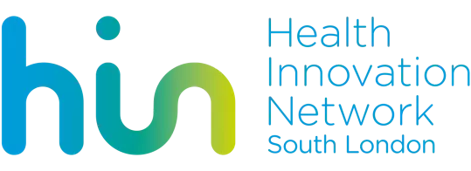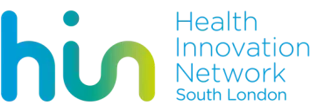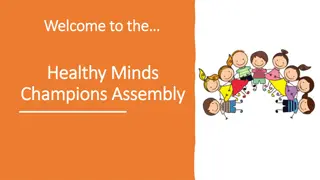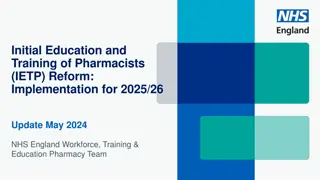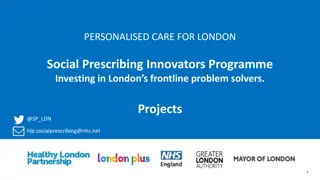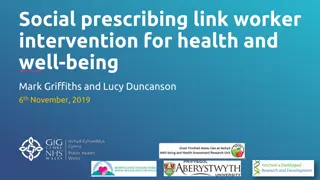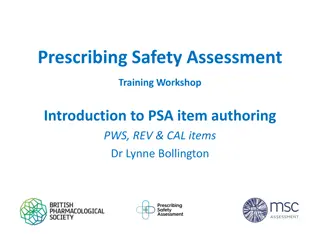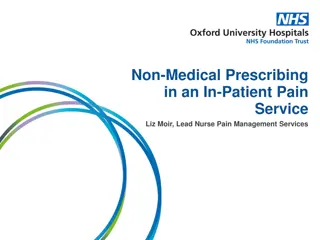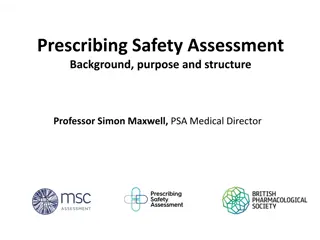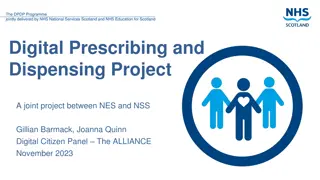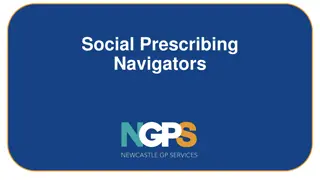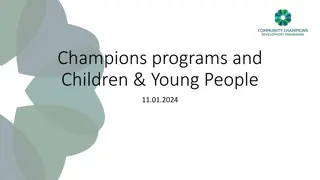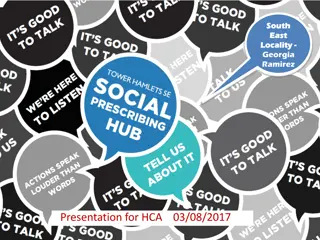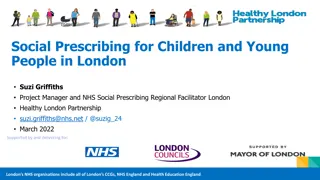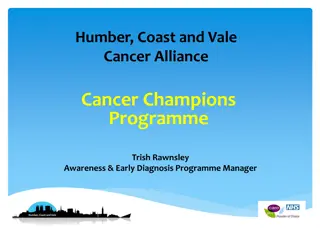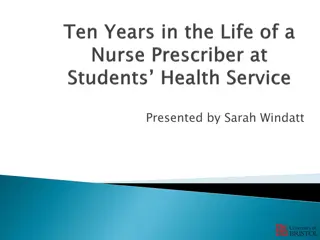Social Prescribing Champions Training Overview
Explore the Social Prescribing Champions Training program offered by HINSouthLondon, focusing on topics like the Social Prescribing model, HealthUnlocked digital platform, communication techniques, and more. Discover the aims of the project, the Health Innovation Network, and the development of primary care workforce in social prescribing. Learn about targeted population groups, self-care practices, and the importance of social connections in promoting health and wellbeing.
Download Presentation

Please find below an Image/Link to download the presentation.
The content on the website is provided AS IS for your information and personal use only. It may not be sold, licensed, or shared on other websites without obtaining consent from the author. Download presentation by click this link. If you encounter any issues during the download, it is possible that the publisher has removed the file from their server.
E N D
Presentation Transcript
www.hin-southlondon.org @HINSouthLondon Social Prescribing Champions Training Fay Sibley
Welcome @HINSouthLondon www.hin-southlondon.org
Course outline Activity Time Welcome and aims of the project 09.30 -09.40 What is Social Prescribing? 09.40 09.50 The Social Prescribing Champions model 09.50 -10.00 HealthUnlocked digital platform 10.00 10.45 break 10.45 11.00 Supporting behaviour change: Communication Techniques and Motivational Interviewing 11.00 -12.30 Red flags 12.30 12.50 Confidentiality and information governance 12.50 13.00 Active signposting 13.00 13.30 @HINSouthLondon www.hin-southlondon.org
Health Innovation Network An Academic Health and Science Network (AHSN) 1 of 15 across England Speeding up the spread of evidence-based innovation in healthcare @HINSouthLondon www.hin-southlondon.org
The Project Aims and objectives of the project Merton and Wandsworth @HINSouthLondon www.hin-southlondon.org
The aims of the project Develop the primary care and voluntary sector workforce in social prescribing Develop a model that can be spread to other areas Increase the number of people who can benefit from social prescribing Pilot the use of a digital platform to support social prescribing interventions. @HINSouthLondon www.hin-southlondon.org
Most complex needs Existing social prescribing schemes Link workers Patients identified Targeted population group Social Prescribing Champions & HealthUnlocked Self-care: using Health Unlocked or other supports Least complex needs @HINSouthLondon www.hin-southlondon.org
Social Loss of independence Social isolation Strained relationships 3. Social 1. Health and Wellbeing 2. Psychological Biological Management Compliance with and effectiveness of treatment 4. Management
Social Prescribing Definition of Social Prescribing Overview of evidence Overview of the model Description of the role @HINSouthLondon www.hin-southlondon.org
What do you understand by the term Social Prescribing ? @HINSouthLondon www.hin-southlondon.org
Social Prescribing Social Economic Environment local, non-clinical services and supports Voluntary and community providers @HINSouthLondon www.hin-southlondon.org
Give an example of when you have seen or used social prescribing @HINSouthLondon www.hin-southlondon.org
The evidence base The evidence suggests social prescribing can reduce the burden on primary and secondary care (Polley et al, 2017). However limited, weak evidence available. Key findings: Reduction in demand for GP services (Kimberlee et al, 2014; Longwill, 2014) Reduction in A&E attendances (Farenden et al, 2015) Reduction in secondary care referrals (Brandling et al, 2011) @HINSouthLondon www.hin-southlondon.org
Role Description Social prescribing champions will: Identify individuals from their day-to-day working who could benefit from sign-posting and social prescribing. Facilitate conversations with people to discuss and identify needs and concerns which they would like to work on. Use the HealthUnlocked platform to identify solutions and opportunities Use motivational interviewing techniques to encourage people to take up the opportunities
The model 3. Social prescription generated and sent to client via email / discussed 1. Conversation with social prescribing champion 2. Identification of needs 4. Follow-up
1. Conversation with a Social Prescribing Champion Social Prescribing Champions will identify clients from their existing work. They will have a conversation using motivational interviewing to explore the clients needs. Champions will take a motivational interviewing approach to help people identify areas of their lives that they may wish to improve by addressing current unmet needs.
2. Identification of needs The HealthUnlocked Platform is a digital tool which can be used to support champions in identifying needs and prescribing social interventions. The health conditions and needs that have been identified during the conversation can be selected on the platform to generate a bespoke prescription .
3. The Social Prescription The prescription takes the form of a personalised, bespoke information sheet which is emailed to the individual. The information sheet could include; condition specific fact sheets, links to national charity websites, links to HealthUnlocked online peer support communities and signposts to local services and organisations. If an individual does not have access to email the prescription can be printed off and discussed with the individual.
4. Follow-up Clients will receive two follow up emails: - 2 days after the consultation - 7 -10 days after the consultation. The email will encourage clients to open the links and take up the social prescriptions which have been recommended to them. The email will include your nickname to make it more personal so please make sure you include this.
Health Unlocked: the digital platform Practical demo @HINSouthLondon www.hin-southlondon.org
Health Unlocked Discover https://merton.healthunlocked.com/ https://wandsworth.healthunlocked.com/
hi Im Tom, Im 72 years old and have COPD, I am a carer for my wife who has dementia. I am struggling to cope I want to help Tom live well and get help with his shopping but I m not sure how I see my GP regularly and I have told her I am struggling to care fro my wife I ve asked Tom to talk to Sandra our Social Prescribing Champion and receptionist @HINSouthLondon www.hin-southlondon.org
Im Geeta, I am currently out of work and feeling quite anxious. I visit the library to work on my CV Putney Wellbeing Friends: Drop in sessions at the library Run by volunteers Mental Health First aid trained Social Prescribing Champions the librarian suggested I talk to the Social Prescribing Champion who runs a drop in session at the library @HINSouthLondon www.hin-southlondon.org
Im Sarah, I work for AgeUK Merton and work with clients to assess their needs I am Mabel, my husband died last year. I don t get out much any more. My daughter phoned AgeUK on my behalf As part of my conversation with Mabel she identified some areas she would like support with @HINSouthLondon www.hin-southlondon.org
Supporting behaviour change Motivational interviewing for behaviour change Practical
Cognitive behavioural restructuring addresses inappropriate health beliefs, catastrophising, maladaptive coping to improve: Physical function Self-confidence Self esteem Social interaction With education we can: Dispel fallacies Encourage self-management
Cycle of change Preparing Thinking Taking action Relapsing Maintaining
Motivational interviewing: an approach to changing behaviour Motivational interviewing is a collaborative, person-centred form of guiding to elicit and strengthen motivation for change The patient, not the practitioner, expresses concerns about current behaviour and expresses arguments in favour of change MI recognises unresolved ambivalence is a key barrier to change
MI model Ambivalence Mixed feelings about change Empathy + guidance Change Change talk Status Quo Desire for change Ability for change Reasons for change Need for change Commitment to change Activation Taking steps Wanting to keep things the same
Collaborative Working with mutual respect and power Patient autonomy Evocative Exploring the possibilities for change Supporting the ability and right to make decisions Ethos of MI Acceptance Affirmation Building self- worth Using empathy Acknowledging strengths and effort
Communication styles In consultations we employ different modes of communication using different methods: Mode Method Directing Informing Guiding Asking Following Listening
Communication styles 60 50 40 Informing 30 Asking 20 Listening 10 0 Directing Guiding Following Need to be mindful of our style Often have a preference Avoid the question-answer trap Adapted from: Rollnick, Miller and Butler
2. Affirmation 1. Open questions Asserting positive feelings, strengths, and effort to lift people s mood and energy for change Evocating elaboration and consideration about change MI communication approach (OARS) 3. Reflecting 4. Summaries of conversations Playing back to show you understand and to raise self- awareness about attitudes, beliefs and values about change Linking and building on reflections to engender a sense of momentum for change Adapted from: Rollnick, Miller and Butler
Practice session 1: Think about you and your clients As a group think about clients and situations you encounter in practice, (e.g. not exercising at home, catastrophizing) Exercise 1: clients What are the situations? Why do we suppose patients behave in these ways? What might be driving these responses? Exercise 2: practitioners Are these responses uncomfortable to deal with? How do you manage them? Does your behaviour aid or hinder? Using MI as an approach how could you support clients in overcoming and changing their attitudes?
Practice session 2: Motivational interviewing skills Break into 3s Pick a behaviour you feel you should be doing (e.g. exercising more, eating healthier, etc.) Three roles: client, clinician and observer 5min conversation 5min feedback in total 1st clinician, 2nd client, 3rd observer Feedback: what was good, what could be improved? Repeat each person in each role
Change process Plan how and when to enact the change i.e. I am going to make this change in these ways Evoke and expand on the possibilities around change i.e. this is what change looks like for me Focus on the topic and process of change i.e. something needs to change for me Engage in the interaction and therapeutic relationship i.e. I trust and I m willing to work these people Adapted from: Wagner and Ingersoll
Engage: in the therapeutic interaction Open and friendly Introduce yourself Introduce the reason for the consultation Encourage participant to start thinking about what is most important to them Adapted from: Wagner and Ingersoll
Focus: on the topic and process of change Bring people to the topic and purpose Explore lifestyles / typical day e.g. What don t you like? What could be better? Explore ambivalence e.g. if things Stay the same: pros/cons Change: pros/cons Explore values e.g. Why is the change important to them? Adapted from: Wagner and Ingersoll
Evoke: possibilities of change Shift to change talk (DARN) Desire, ability, reason and need for change Explore new possibilities and ideas not considered before What could the future look like? Explore strengths and self-confidence relating to change Building on past successes Praise recent efforts Adapted from: Wagner and Ingersoll
Evoke: possibilities of change Reiterate change is a process over time Can use cycle of change model Where are they now, where do the want to be? Taking action Preparing Thinking Maintaining Not ready Relapsing
Plan: how to move to action Reinforce the importance of the change to them and their self-confidence in being able to change Readiness to change Why might you want to change? Change Importance How might you want to change? Confidence
Plan: how to move to action People must believe: They have a plan They can enacted it They can stick with it Support people to develop plan for change What s the change I want to make? Reasons for changing are ? Steps I ll take are ? People will help me by ? I ll know it s working if ? Things that could get in the way are ? Things I ll do to limit this are ? Adapted from: Wagner and Ingersoll
Relapse Prevention ASK: Thinking about the next few weeks, what might get in the way of you achieving your goals and carrying out your action plan? Identify Triggers: Holidays Injury Stress/emotional situations Pain Small lapses into old habits Low motivation Bad weather Taking action Preparing Maintaining Relapsing Thinking
Social Prescribing Champions: Scope of practice What do we do when a patient requires additional support What are red flag symptoms Who can you access for support
Raising a safeguarding concern What are the different types of abuse? What are your existing methods of raising concerns? As a group brain storm what you would do to raise a safeguarding concern
What are Red flags? Red flags are a check list to help us identify clients with a serious underlying condition. It is rare for clients to have any red flags. Red Flags: Weight loss unexpected or unexplained Feeling persistently unwell malaise lasting longer than 2 weeks Pain on rest or being woken from sleep by pain Stiffness lasting more than an hour Numbness or pins and needles in the saddle region Any red flags identified refer client to GP urgently
Additional support Line manager Social Prescribing Champions (peers) Health Innovation Network Weekly phone calls Bi-monthly drop-in clinics Fay and Josh s email addresses Is there additional support you want to receive from us? Facebook Whatsapp
Signposting What do we mean by sign posting? In your table think about the types of clients you will see and the services available to you?
Troubleshooting Emails going to spam Living on the boarder or between boroughs Client doesn t have an email Client wants to come back for a follow up



